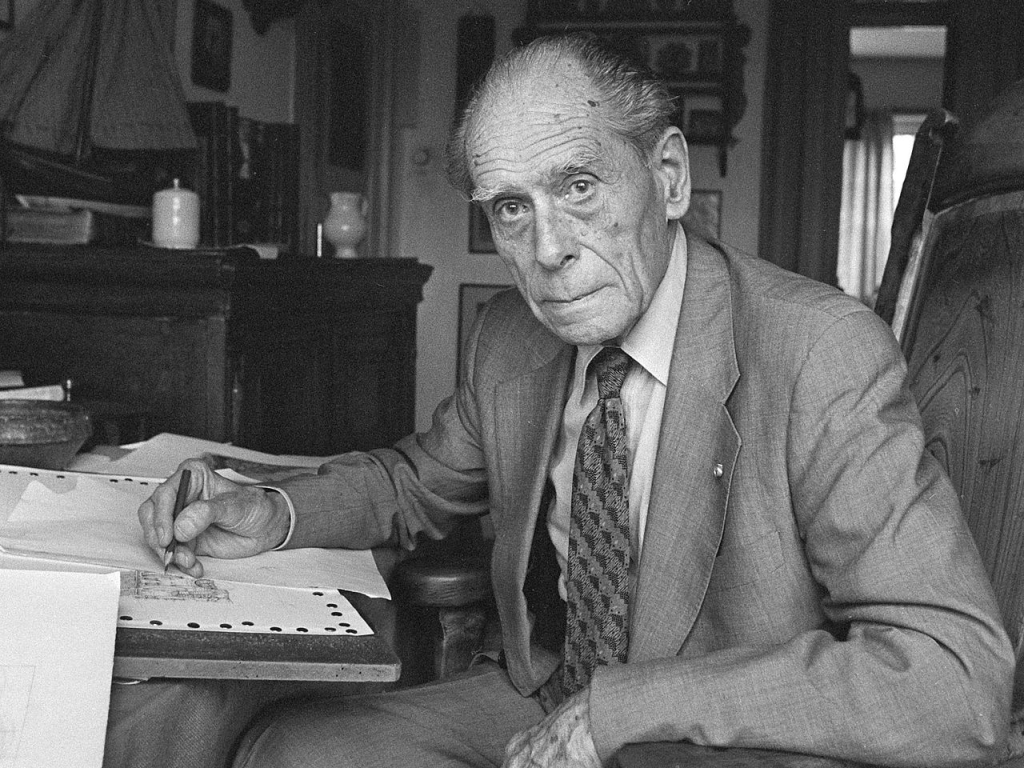
Anton Pieck
When one thinks of artists, one looks to the greats such as Veronese or Goya or Turner and some are maybe somewhat “sniffy” when graphic artists and illustrators are lumped together with such luminaries. My artist today was reviled by serious art lovers for his artwork being petty kitsch. Still, friend and foe had to admit that he was an accomplished draftsman with a highly unique, instantly recognizable and barely imitated style. However, whether you love or hate his work my featured artist today is one of the great illustrators of his time and whose works have brought unbridled happiness to many. For those who have never seen any of his works, let me introduce you to the Dutch graphic artist Anton Pieck.
Anton Pieck aged 1 year-old, on the left, next to his twin brother Henri Pieck
Anton Franciscus Pieck and his twin brother, Henri, were born in the Dutch town of Den Helder on April 19th, 1895. He was the son of Henri Christiaan Pieck, who was a machinist in the Royal Dutch Navy, so he was often away from home for lengths of time. His wife was Stofffelina Petronella Neijts who gave birth to their first child, Coenraad, in 1891 but who died when he was just one year old. Anton’s twin brother Henri Christiaan became a Dutch architect, painter and graphic artist but who would lead a different, more exciting and dangerous life than his brother Anton. As an adult Henri became active within the Dutch Communist Party, and was recruited as a spy for Soviet Russia. Henri’s artistic interests differed from those of Anton as his main love was modern art, whereas Anton loved old-fashioned illustrations and paintings . When the twins were six years old, they took drawing lessons from J. B. Mulders, who ran after-school art classes at their school. He recognized the talent of the twins and taught them the basics of perspective and proportion, and these lessons quickly bore fruit. When he was ten, Anton won a prize at an exhibition for his still life watercolour depicting a brown pot on an old stove, and in recognition, among other things, he received five tubes of watercolour paints. More awards followed during his teenage years.
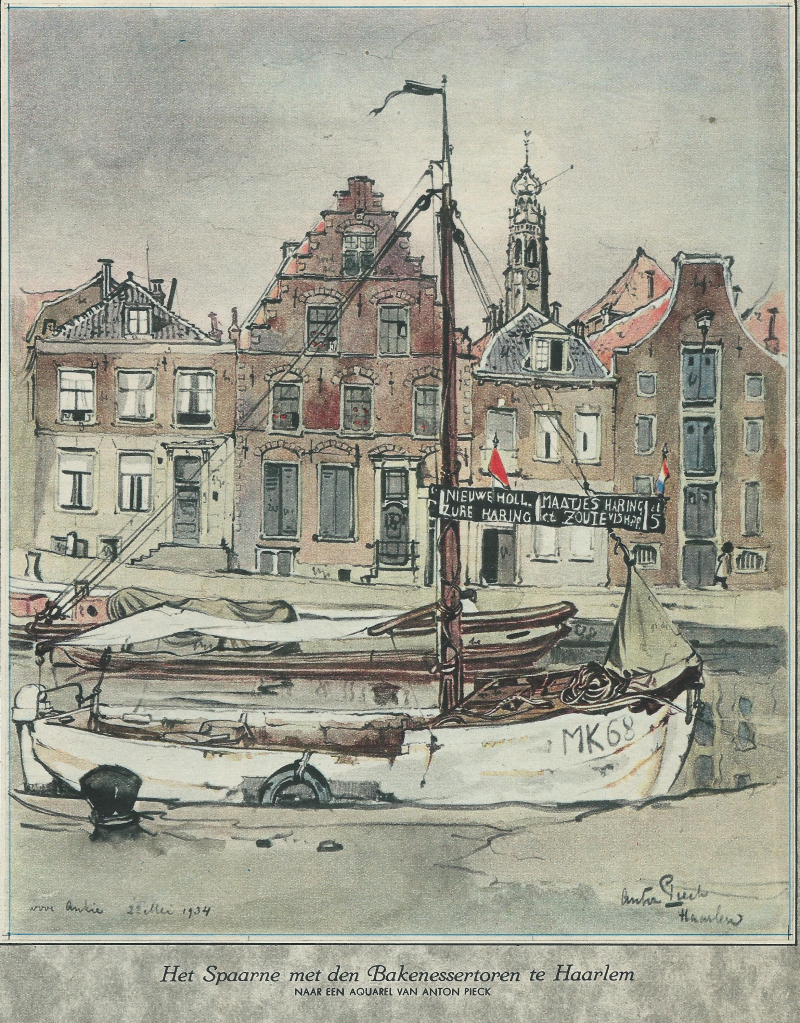
River Spaarne and the Bakenesser Tower by Anton Pieck
In 1906, after Anton’s father retired, the family moved to live in The Hague. Anton and his brother, after finishing secondary school, enrolled on a drawing course in the evenings at the Royal Academy of Art. They later received training at the drawing institute Bik and Vaandrager. When the brothers were aged fourteen, they obtained the first stage of their teaching certificate and 3 years later they completed their teaching certificates and were able to call themselves drawing teachers. Anton went to teach at his old school, Bik and Vaandrager. Henri Pieck was considered the better artist of the twins and is allowed to go to the Academy of Fine Arts in Amsterdam. This was a personal blow to Anton who never came to terms with the fact that his twin brother was looked upon as the more skillful artist. One could almost say that Henri was looked upon as an artist whereas Anton was looked upon as a drawing teacher!
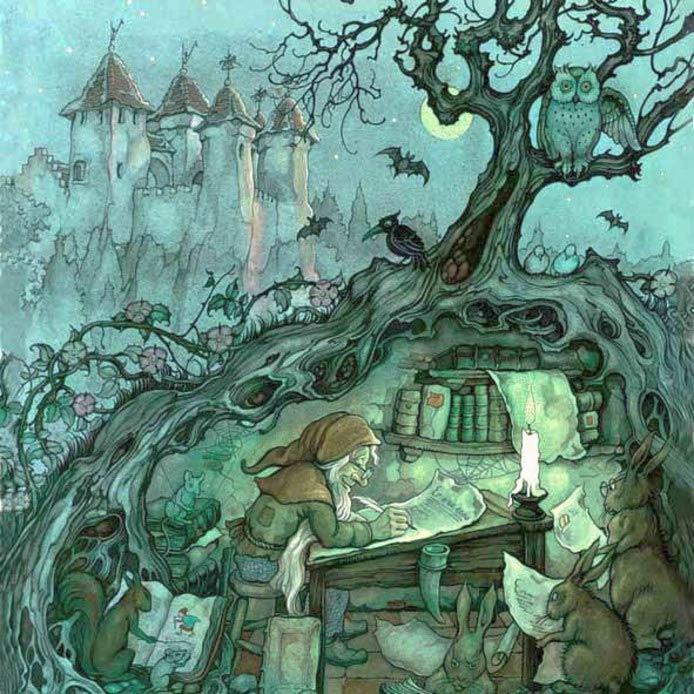
During the First World War the Netherlands remained neutral, but still many young Dutchmen were mobilized so as to be on standby in case their country became embroiled in the fighting. Anton Pieck was one of those men and became a sergeant, however he spent most of his spare time sketching for his fellow recruits. A somewhat damning psychological army report on him in 1915 described Pieck as:
“…someone who looks more at the past than the future and will therefore never amount to anything…”

Not considered as “fighting material” and unlikely to be used for military duties, Pieck was sent back to The Hague, where he gave drawing lessons to other soldiers. This was pure heaven for Anton as for four evenings a week he would oversee two-hour sketching lessons. Pieck was then able to spend all his time doing what he loved best.
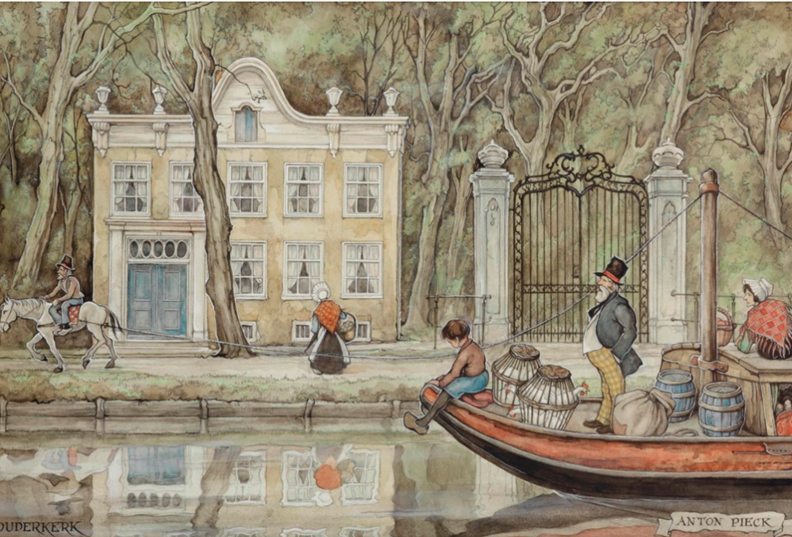
A boat on the River Amstel near Ouderkerk with the house “Wester Amstel” by Anton Pieck
When Anton graduated from the Bik en Vaandrager Institute, they offered him the position as an art teacher which he accepted and held the position until 1920. He then applied and was accepted as an art teacher at the newly established Kennemer Lyceum, a high school in the Haarlem suburb of Overeen. He would continue to work there until his retirement in 1960 at the age of 65. Throughout those years teaching students, he always made time for his own work.
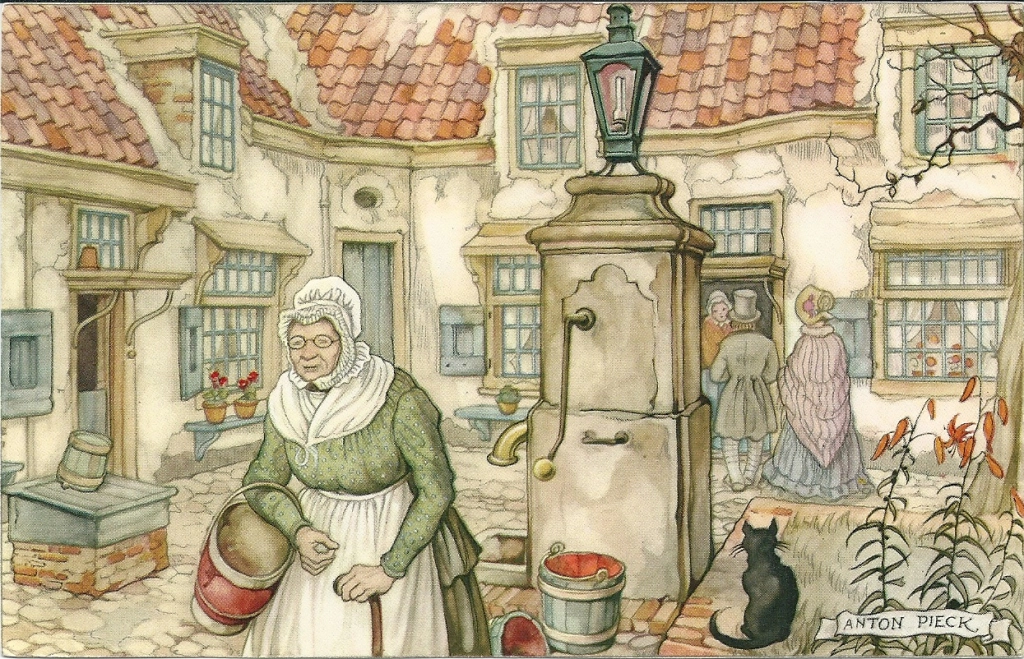
Hofje van Loo with communal water pump by Anton Piecke. The Hofje (Courtyard) van Loo is a hofje on the Barrevoetstraat 7 in Haarlem
Teaching art was not his great love and he was never quite satisfied with his job and he couldn’t wait for his daily teaching duties to end so that he could dash home and continue drawing and painting. However, being employed as a teacher gave him financial stability and this in turn gave him the comfort of only choosing commissions which pleased him, rather than being forced to work on work he disliked. Whilst employed at the school as a teacher, Anton would also illustrate diplomas, bulletins, ex-libris bookplates, birth cards and other administrative documents for his school.
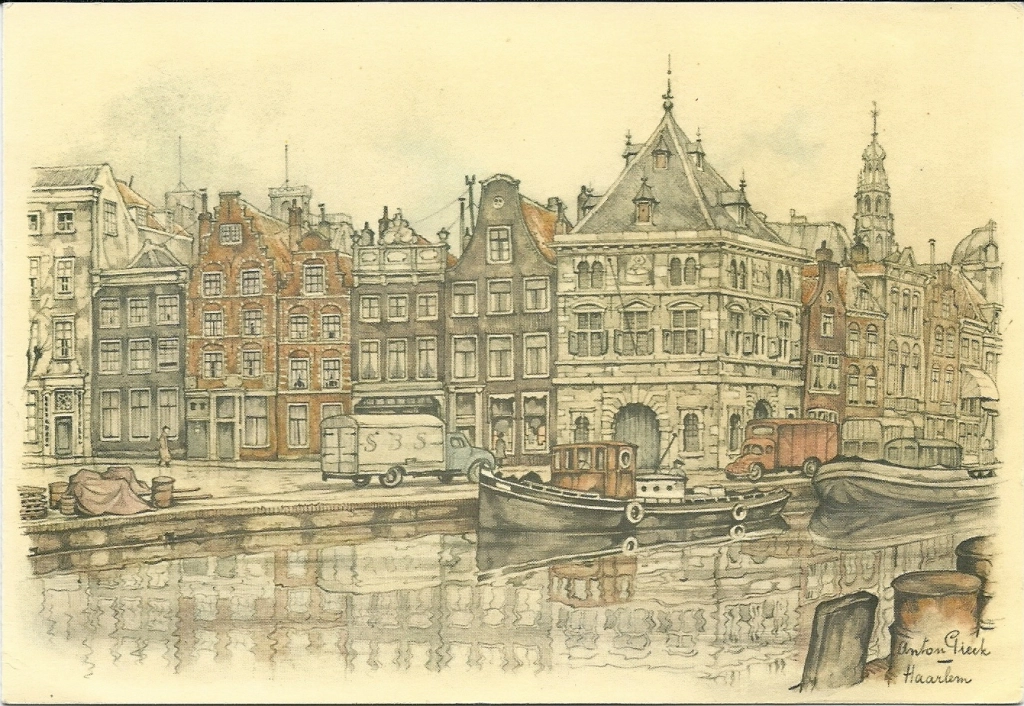
The River Spaarne with the Waag building designed by Lieven de Key at the end of the 16th century by Anton Pieck
In the 1920’s Anton Pieck published his first drawings. It was also around this time that Anton forged a close friendship with the Flemish novelist Felix Timmermans and it is said that Timmermans’ jovial attitude rubbed off on Pieck whom he advised to “lighten up” and be more spontaneous and follow his own spirit.
A recent edition of Felix Timmerman’s book.
For the 10th edition of Timmerman’s very successful book, Pallieter, published in 1921, Timmermans asked Pieck to provide the illustrations to go side-by-side with the text. Through correspondence, Timmermans indicated what he wanted to see on the illustrations. The book was described as an ‘ode to life’ written after a moral and physical crisis. Pallieter was warmly received as an antidote to the misery of World War I in occupied Belgium. For Pieck, this was just a start of his book illustration journey as he went on to illustrate about 350 books.
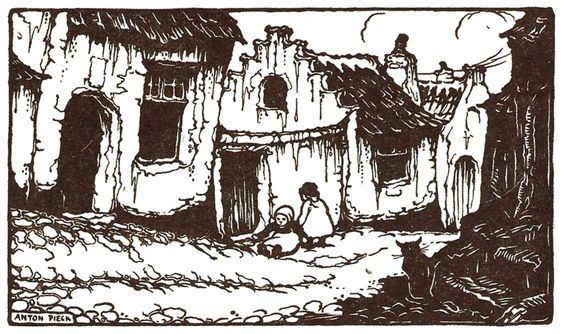
In 1921 Pieck illustrated Felix Timmermans’ book Pallieter by the Flemish author Felix Timmermans. As the book was set in Flanders Pieck decided to visit there to soak up the atmosphere in the various towns. Above is an ink illustration from one of the chapters, A beautiful winter day in which the main character, Pallieter, goes out on a clear winter day and hears organ music. He heads towards the sound, but only sees two children playing with mud.
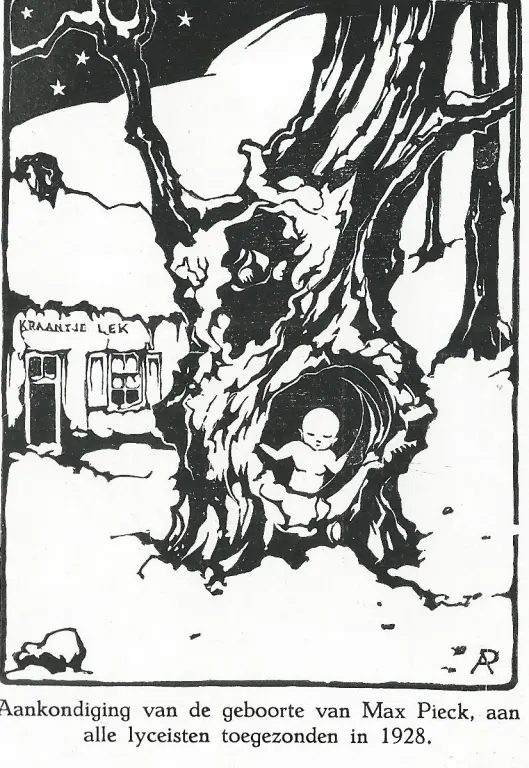
Anton Pieck’s way of announcing the birth of son Max Pieck sent to all the staff of the Kennemer Lyceum in 1928
In 1917, Anton Pieck met Jo van Poelvoorde, the sister of fellow soldier Hendrik van Poelvoorde. Jo was a teacher at the Royal Dutch Weaving School. Her first impressions of Anton were that he was friendly, but also taciturn and absent. Gradually he opened up more and became more talkative. Anton and Jo entered into a relationship and twenty-seven-year-old Anton Pieck married twenty-nine-year-old Josephina Johanna Lambertina (Jo) van Poelvoorde, on March 8th 1922 at The Hague. After the marriage the couple moved to Overveen. From their marriage three children were born, Elsa, Anneke and Max.

Harpenden Engeland by Anton Pieck
Throughout his life, Anton was an enthusiastic traveller and visited England, France, Ireland, Germany, Sweden, Switzerland, Austria, Italy, Poland and Morocco during which he built up a collection of sketches. He was a great lover of quaint buildings and had no interest in modern architecture. For him, it was a joy to study nature as well as picturesque cities and villages. He was so in love with Belgium and England that he termed them “his second mother countries” as their towns had not been “ruined” by modernisation as had happened in his homeland The Netherlands.
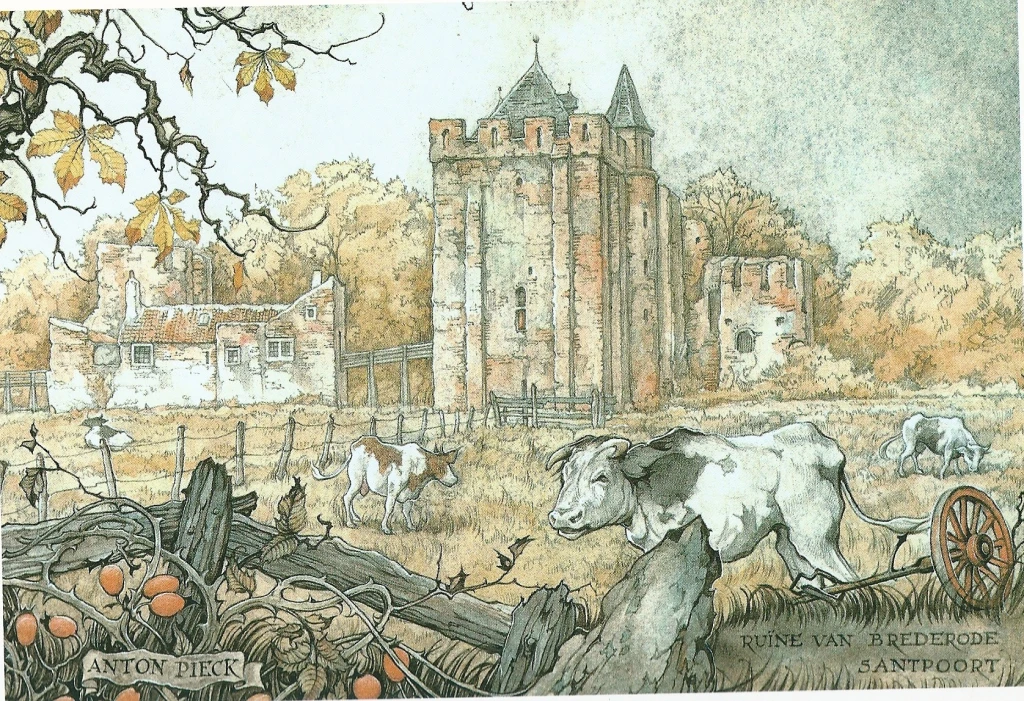
The ruins of Brederode in Santpoort by Anton Pieck (c.1950)
Anton Pieck was a twentieth century man as he only lived his first five years in the nineteenth century. Having said that, Pieck loved to look back with pleasure on what he considered to be a more appealing century – the nineteenth century.
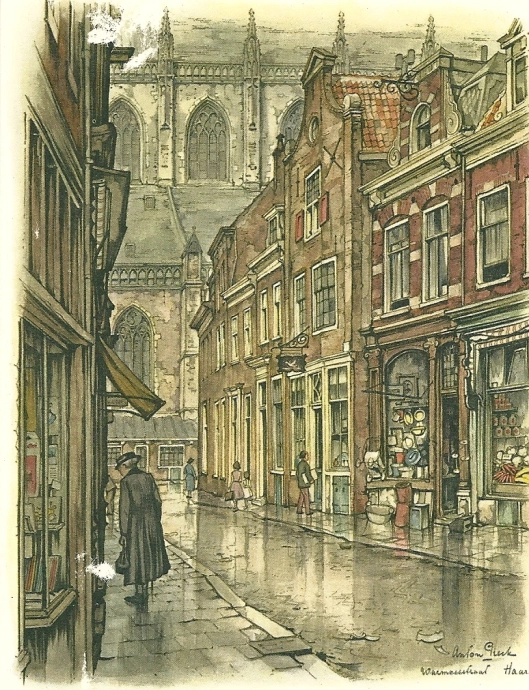
The Warmoesstraat, Amsterdam by Anton Pieck
He had fallen in love with the Dickensian era and had completed many paintings, drawings, etchings and engravings depicting Dickensian scenes. He depicted gentlemen in high hats or ladies adorned in crinoline, people taking coach rides, watching a magic lantern show or listening to barrel organs or chamber concerts. All such scenes gave him great pleasure and they all contributed to his artistic ideal. Anton Pieck was adamant that when it came to commissions, he would only accept those which allowed him to illustrate novels or short stories set in bygone days.
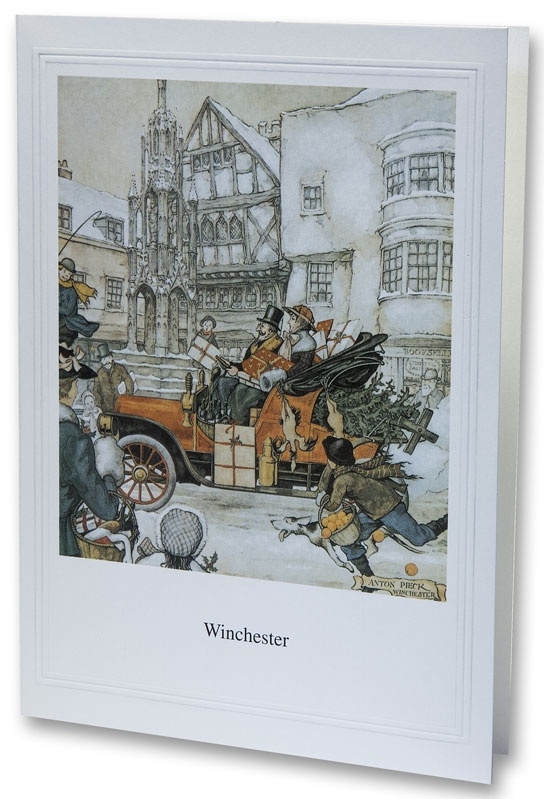
Greeting card of Winchester by Anton Pieck
What Pieck liked to depict were things which looked old or dilapidated. Buildings and their interiors which were crooked and looked ramshackle and run-down. For Anton, nothing was to look new or be built completely straight. Anton’s first visit to England appears to have been around 1937 when, on a voyage by ship to North Africa, he had managed to come ashore in Southampton and was able to made sketches of some of the old commercial buildings and to visit the city of Winchester where he sketched some of the old Tudor buildings and historic inns, one of which was turned into a greetings card.
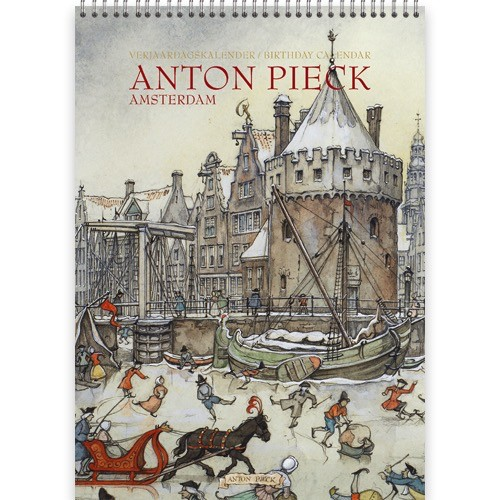
Besides prints and greeting cards, calendars were produced each year with a selection of Anton Pieck’s drawings.
He would also produce a number of ex libris bookplates, a book owner’s identification label that was usually pasted to the inside front cover of a book. Above is one he created for his son, Max.
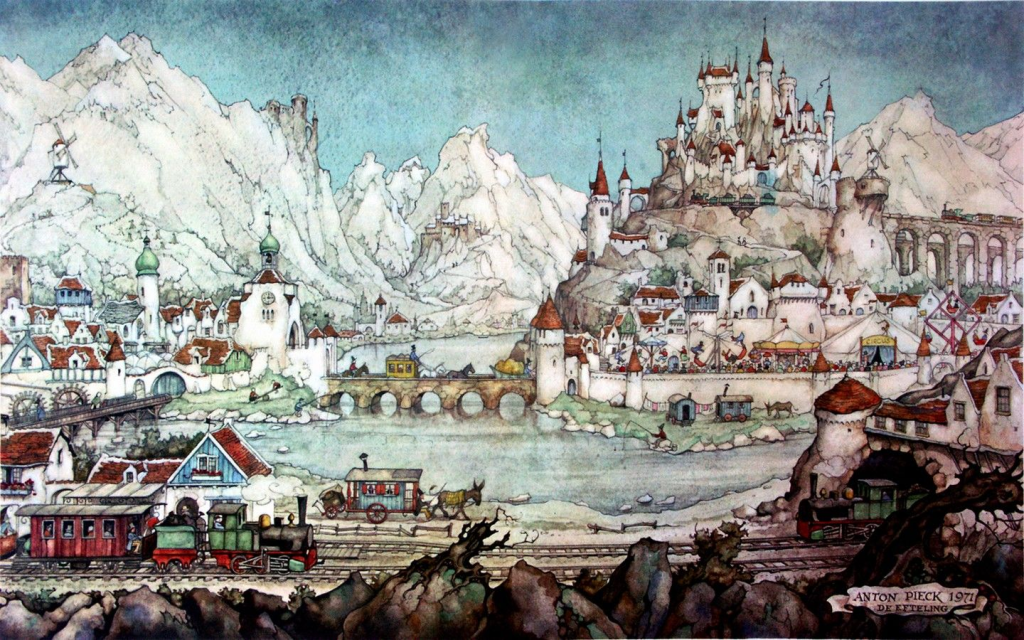
Anton Pieck’s vision for De Efteling
Anton Pieck’s work over the years and his popularity with the Dutch people was probably in the minds of the mayor of Loon op Zand, R.J. van der Heijden and filmmaker Peter Reijnders who had envisioned the building of a fantasy-themed amusement park, De Efteling, in Kaatsheuvel in the Dutch province of North Brabant in 1951, named after a 16th-century farm named Ersteling. The men approached Anton Pieck to design the theme park but he initially refused but later changed his mind on the proviso that only original materials are used for building the houses, such as coloured roof tiles and old stones. Anton then set about designing het Sprookjesbos, the fairy tale forest.
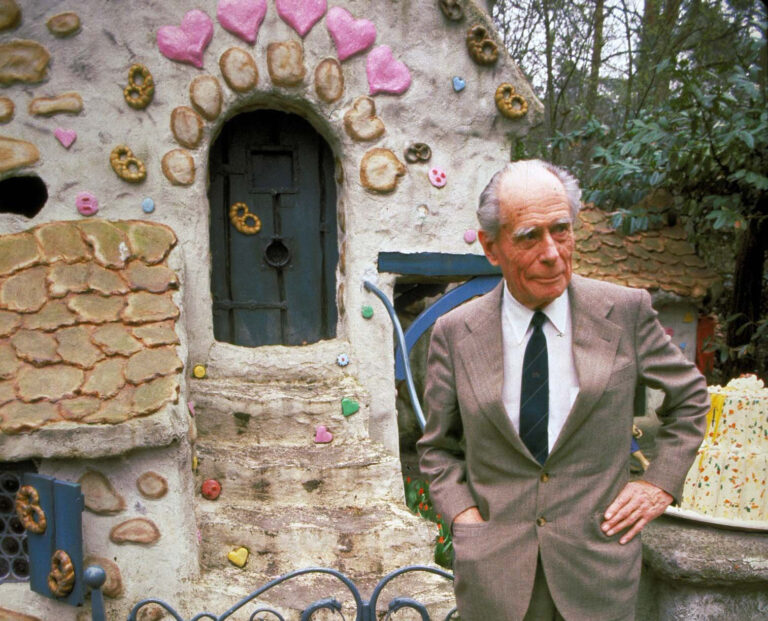
Anton Pieck at Efteling
Initially, the Fairy Tale Forest was designed and based upon ten different fairy tales, all of which were brought to life using original drawings by Pieck. Added to Pieck’s designs were mechanics, lighting and sound effects designed by the Dutch filmmaker Peter Reijnders. The life-sized dioramas, shown together in an atmospheric forest, were a incredible success and in 1952, the first full year, Efteling was open, it had 240,000 visitors and since 1978, the park has grown in size and is now become one of the most popular theme parks in the world.
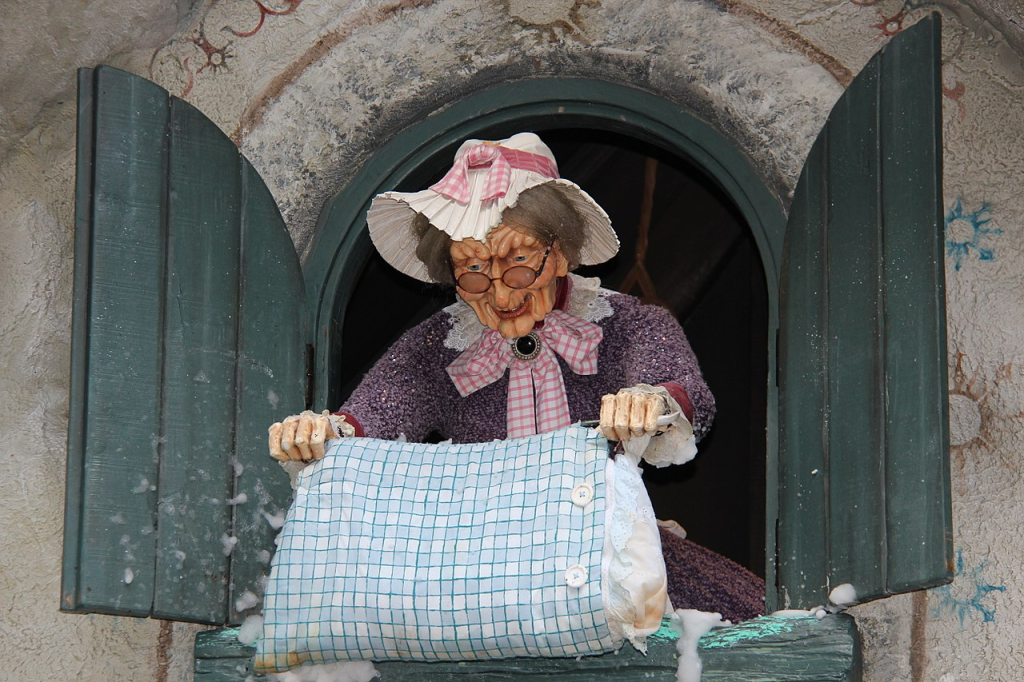
Frau Holle at Efteling
Pieck designed all the houses, buildings and the special animatronic inhabitants who were inhabitants of the fairy tale forest, such as Little Red Riding Hood at her grandma’s house, Sleeping Beauty’s castle, Frau Holle’s well and Hansel and Gretel’s gingerbread house. Frau Holle, also known as Mother Hulda, is a German fairy tale character from the 1812 book, The Grimm Brothers’ Children’s and Household Tales (Grimms’ Fairy Tales).
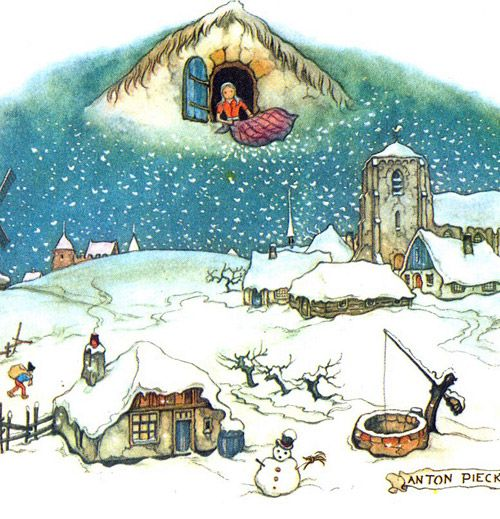
Frau Holle by Anton Pieck
Frau Holle is often depicted shaking out bed linen over an outside balcony then it begins to snow. It is still a common expression in Hesse and Southern parts of the Netherlands and beyond to say “Hulda is making her bed” when it begins to snow. Like many other tales collected by the Brothers Grimm, the story of Frau Holle was also a moral tale explaining that hard work is rewarded and laziness is punished.
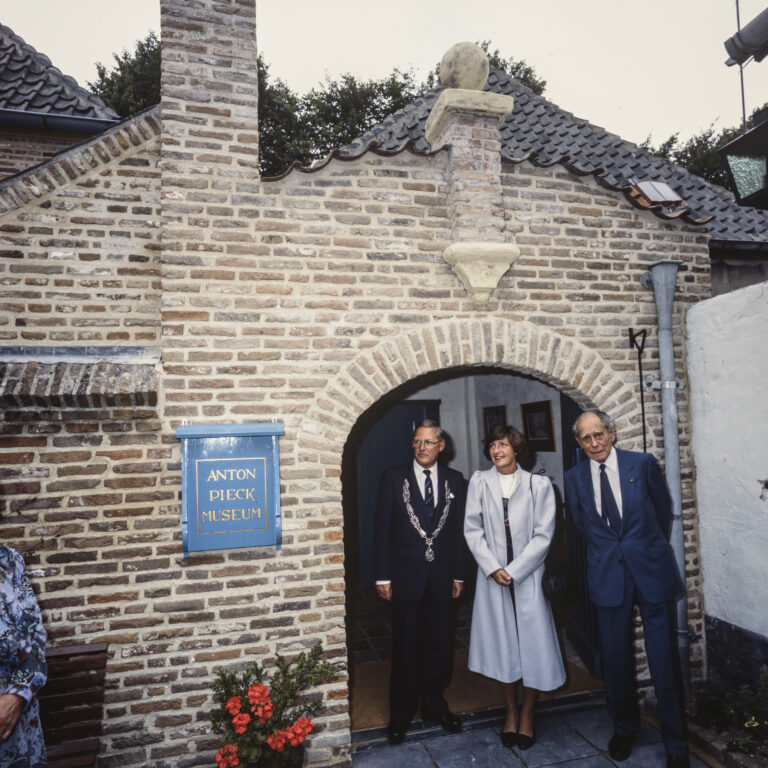
Anton Pieck Museum
Anton Pieck retired from teaching in 1960. He was made a Knight in the Order of Orange-Nassau. Pieck died on November 24th 1987 at the age of 92. Three years before his death the Anton Pieck Museum House for Anton Pieck was opened in Hattem, a municipality and a town in the eastern Netherlands.
Anton Pieck loved nature, the past and Dutch cityscapes. Sadly, during the course of the 20th century, large swathes of that old Netherlands he loved disappeared due to bombing during the war, the renovation and rejuvenation of the city centers from the 1960’s and the construction of the complicated road network. As a result, Anton became sad and depressed at what he witnessed during his latter years, saying in 1985:
“… Yes, I have known this country very well. What is still there now, I see as a mess of the past. That makes me sad, yes…”
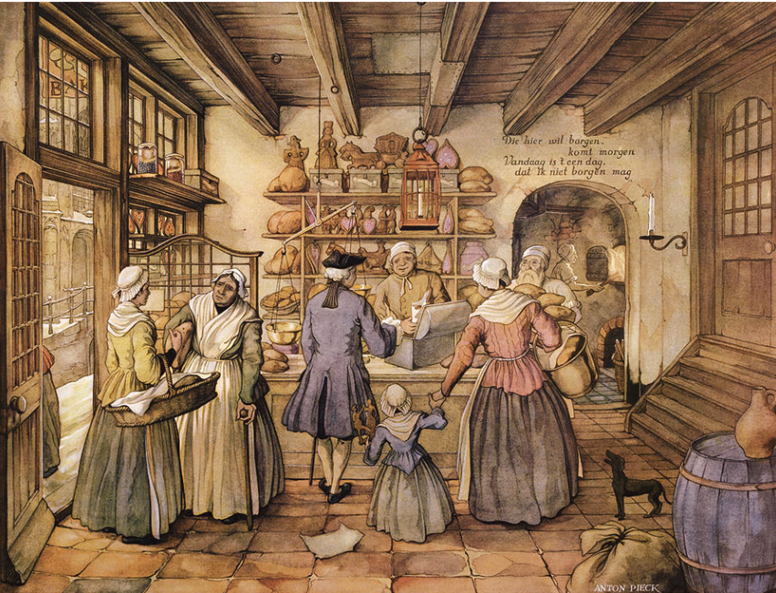
Whatever you may think about the artistic style of Anton Pieck, one has to feel warmed by the depictions and undergo a desire to be back in olden days when life may have been simpler, or was it ?







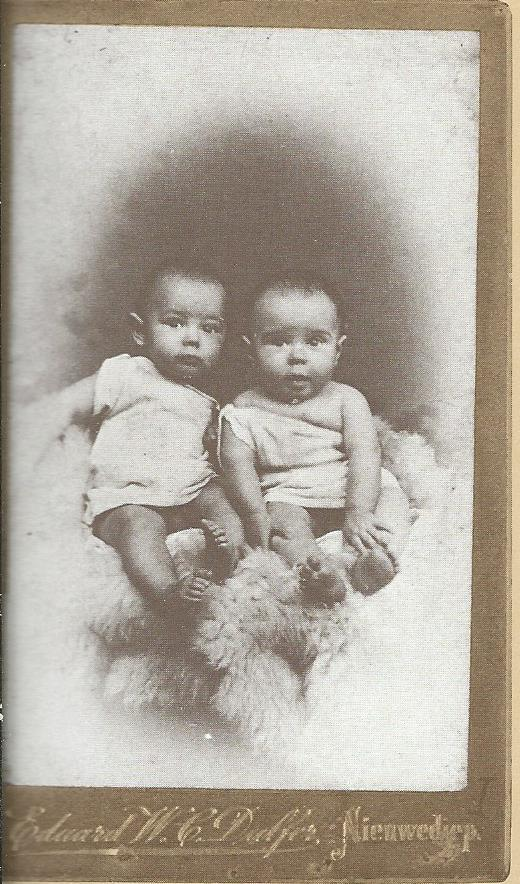
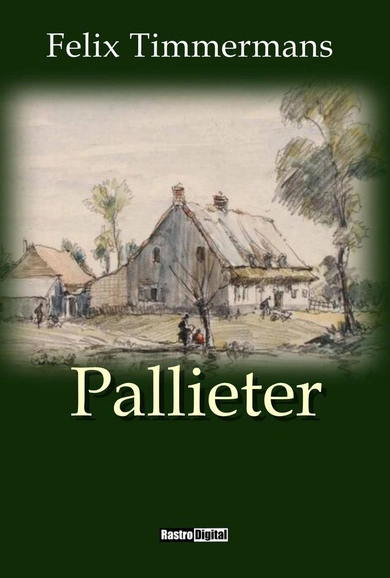
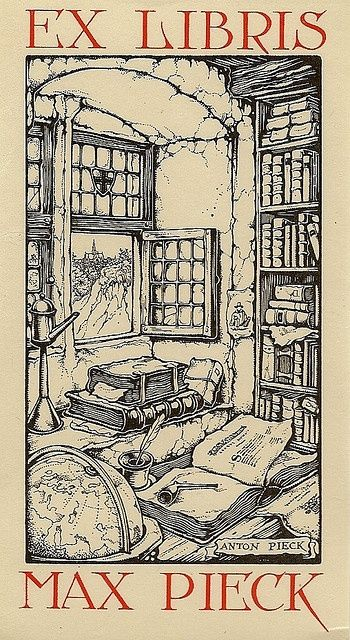



More Stories
MAKING A MARK: Portrait Artist of the Year
Expanding Your Skillset to Respond to Opportunities with Detour
Transplant Links Charity Deck of Cards